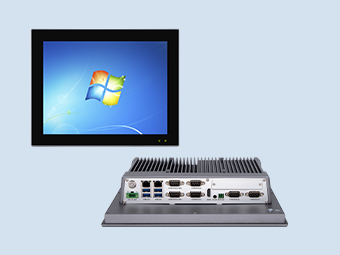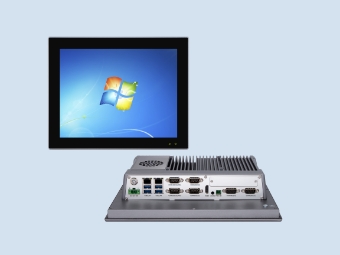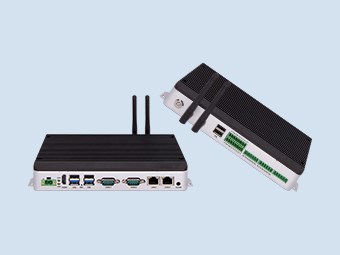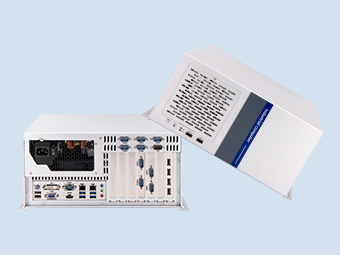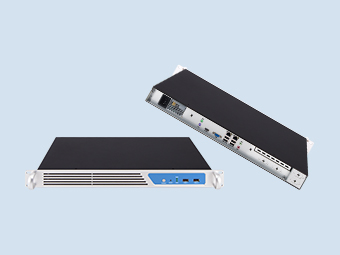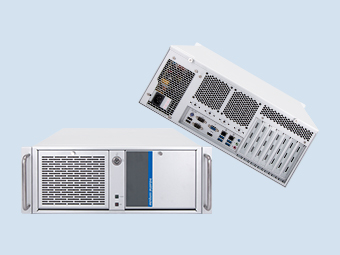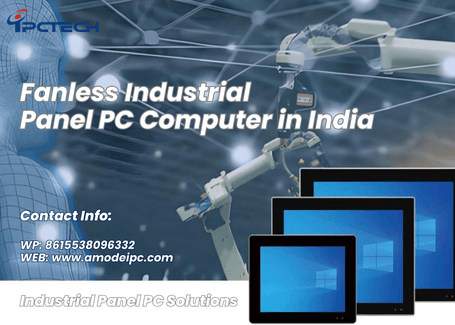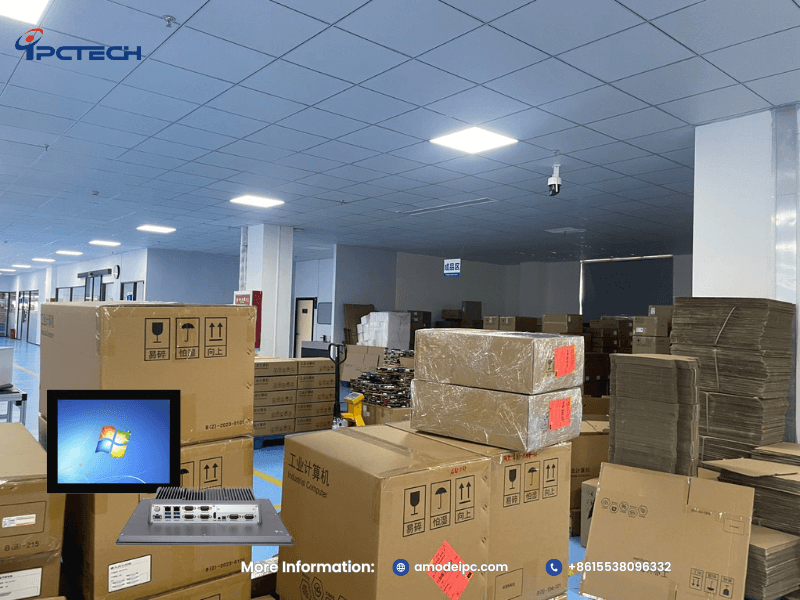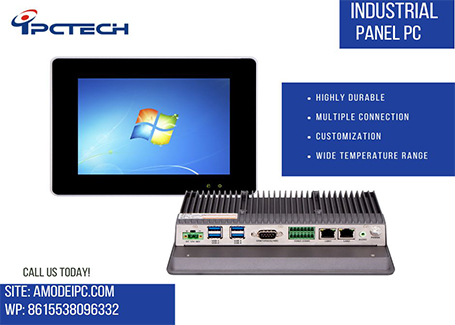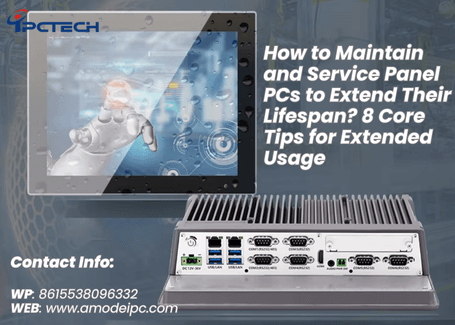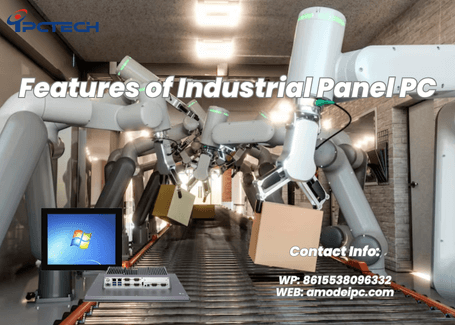Why Fanless Industrial Panel PCs Last Longer in High Heat
2025-09-18
In industrial production settings, environments such as manufacturing workshops, refineries, and outdoor smart kiosks often exceed temperatures of 40°C (104°F), with some extreme scenarios reaching over 70°C. For industrial tablet PCs supporting equipment monitoring and data acquisition, high temperatures pose not only a performance challenge but also a significant threat to longevity. Traditional fan-based industrial tablets frequently fail in such environments: fan motors burn out from heat, dust accumulates in airflow paths blocking cooling channels, and internal components age prematurely under sustained high temperatures. Fanless industrial tablets, however, deliver long-term stable operation. Their core advantage lies in multi-dimensional optimizations—passive cooling design, absence of vulnerable components, and enhanced environmental protection—making them the top choice for target customers.
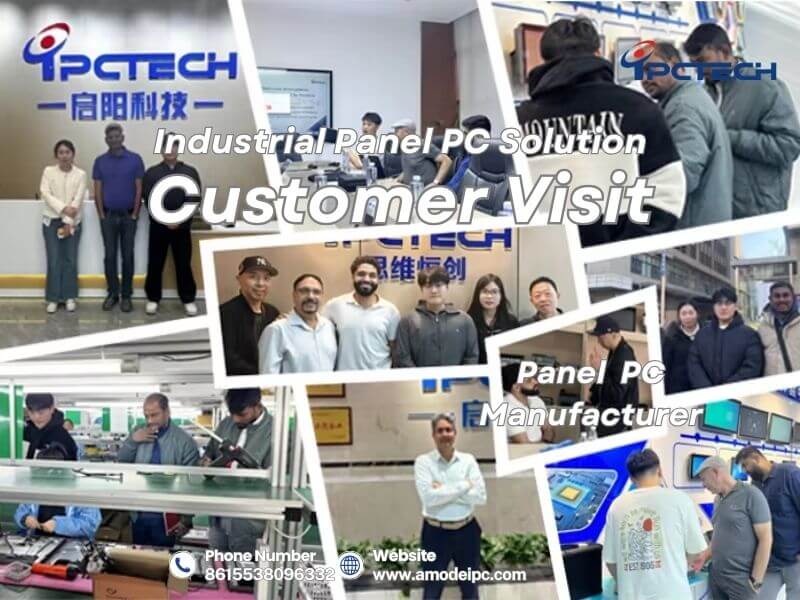
Passive cooling is the core technology enabling fanless industrial tablet PCs to withstand high temperatures. It eliminates reliance on active fan ventilation, achieving efficient heat dissipation through physical structure design. This fundamentally addresses the limitations of active cooling in high-temperature environments.
The cooling system of fanless industrial tablet PCs is designed around a dual-phase “heat conduction - heat dissipation” process:
First, efficient thermal conduction—utilizing high-purity aluminum alloy casings with a thermal conductivity of approximately 155 W/(m·K), over 50 times that of standard plastic enclosures. This rapidly absorbs heat generated by core components like CPUs and GPUs. Premium models further incorporate graphite thermal pads or copper heat pipes between chips and casings to reduce thermal resistance and prevent internal heat buildup.
Second, maximized heat dissipation—the shell surface employs a finned design. By incorporating textured ridges and grooves, the heat dissipation area is expanded (in some models, up to three times that of a standard flat shell). Heat is rapidly transferred through the fins into the surrounding air, enabling efficient heat exchange via natural convection even in environments as hot as 50°C.
For high-load scenarios (e.g., multi-task data processing), select models incorporate locally thickened thermal layers near critical components (like power modules) to prevent localized hotspots.
Traditional fan-equipped industrial tablets experience steep declines in cooling efficiency as temperatures rise: When ambient temperatures exceed 40°C, the lubricant in fan motors gradually thins, reducing rotational speed by 20%-30% and simultaneously diminishing cooling capacity. If temperatures exceed 50°C, the grease may solidify completely, causing the fan to seize. Heat becomes trapped, triggering CPU thermal throttling that reduces performance by over 50% or even causing shutdown due to overheating.
Passive cooling avoids moving-part failures: its efficiency remains linearly stable with rising ambient temperatures. As long as temperatures stay below component tolerance limits (typically 70°C), it continuously dissipates heat. Additionally, passive cooling eliminates fan power consumption, reducing overall system power usage by 15%-30% compared to fan-equipped models. This translates to lower heat generation from internal components, creating a positive feedback loop of “low power consumption → reduced heat generation → enhanced durability.”
The fan in traditional industrial tablets is the most vulnerable component in high-temperature environments. Fanless designs minimize failure risks by eliminating all moving parts, significantly extending mean time between failures.
Core failure risks for fans stem from mechanical wear and high-temperature aging:
• Bearing wear: Fan bearings rely on grease to reduce friction. When ambient temperatures exceed 50°C, grease evaporates rapidly, causing direct metal-to-metal contact. This increases the friction coefficient by 3-5 times, generating noise and causing fan speed fluctuations with unstable cooling. If temperatures continue to rise, bearings may deform from overheating and seize completely.
• Motor overload: To maintain cooling efficiency, fans must operate at full load in high-temperature environments, with motor current 15%-20% higher than in standard conditions. Prolonged overload accelerates coil insulation degradation, leading to “short-circuit burnout” failures.
Note: In environments exceeding 40°C, 60% of industrial tablet failures are directly fan-related, requiring fan replacement every 6-8 months on average. This not only increases maintenance costs but also causes production interruptions.
Fanless industrial tablets eliminate fans and simplify internal structures, achieving “fewer components = fewer failures”:
• Internal components are limited to fixed elements like chips, PCBs, and interfaces—no rotating or moving parts, eliminating wear-and-tear issues;
Average Mean Time Between Failures (MTBF) exceeds 50,000 hours (approx. 5.7 years)—2-3 times longer than fan-equipped models (20,000 hours, approx. 2.3 years). Even under continuous 60°C operation, the annual failure rate of fanless models remains only 3%-5%, significantly lower than the 15%-20% rate of fan-equipped models.
High-temperature industrial environments often involve significant amounts of dust (e.g., metal shavings in steel mills, cement dust in cement plants) and oil contamination (e.g., paint mist in automotive coating workshops). These contaminants can be drawn into equipment through fan airflow, becoming major heat dissipation obstacles. Fanless designs address this issue at its root through sealed protection.
The active air-intake design of fan-equipped industrial tablets simultaneously draws in environmental contaminants:
• Dust entering with airflow adheres to gaps in CPU heat sinks, forming dust layers within 1-2 months. This increases thermal resistance by over 50%, causing a sharp drop in cooling efficiency.
• Oil residue or metal shavings entering the fan interior can become lodged between bearings and blades, accelerating wear and potentially causing blade fractures;
In real-world testing within automotive welding shops (45°C+ temperatures with metal dust), fan-equipped industrial tablets exhibited 0.5mm dust accumulation on heat sinks after just 3 months of operation. CPU temperatures rose by 15°C compared to new units, resulting in frequent automatic reboots.
• The enclosure employs an “integrated molding process” with no fan vents, featuring silicone gaskets for “dustproof and waterproof” performance. Mainstream models meet IP65 or IP67 protection ratings (IP65: complete dust protection, resistant to low-pressure water jets; IP67: Complete dust protection, withstands temporary immersion in 1 meter of water);
• Ports feature a “sealed design,” with rubber dust covers on USB, Ethernet, and other interfaces to prevent dust ingress through gaps. Some models also apply conformal coating to the PCB, preventing circuit shorting even if minor dust enters.
During steel mill operations, fanless industrial tablets (IP65-rated) operated continuously for 2 years in 60°C+ high-dust environments. Post-operation inspection revealed no significant internal dust accumulation, with component corrosion rates 80% lower than fan-equipped models. Performance remained above 90% of initial specifications.
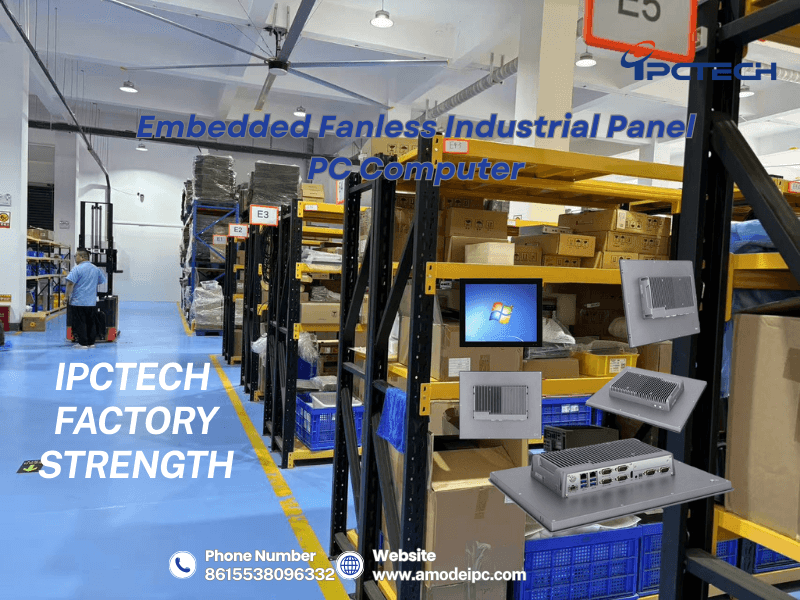
The durability of fanless industrial tablets relies not only on external design but also on industrial-grade component selection—all core parts undergo wide temperature testing to ensure stable operation within the extreme range of -40°C to 70°C, far exceeding the tolerance limits of consumer-grade components.
Industrial-Grade vs. Consumer-Grade: The Temperature Tolerance Gap
Consumer-grade components are designed for controlled indoor environments and are highly susceptible to failure in high temperatures. Industrial-grade components achieve superior heat resistance through material upgrades and structural optimization:
• CPU: Utilizes wide-temperature SoC operating from -40°C to 70°C. Even under full load at 65°C, it avoids throttling or crashes. Consumer CPUs, however, have a maximum operating temperature of just 40°C and frequently trigger thermal throttling beyond this threshold.
• Storage: Features industrial-grade SSDs without mechanical heads. Dynamic thermal management technology adjusts read/write speeds in real-time to prevent chip damage at high temperatures. Their tolerance range spans -40°C to 85°C, whereas consumer HDDs experience increased friction between heads and platters above 45°C, elevating data error rates by over 10 times;
• Passive Components: High-temperature rated capacitors and resistors are used, such as electrolytic capacitors rated for 105°C (consumer-grade typically 85°C). Even in 70°C environments, their lifespan exceeds 10,000 hours—2.5 times longer than consumer-grade capacitors.
Component High-Temperature Reliability Testing
To ensure component stability in high-temperature environments, fanless industrial tablets undergo multiple rounds of extreme testing before shipment:
• Thermal cycling test: Devices are repeatedly switched between -40°C (low temperature) and 70°C (high temperature) (1 cycle = 2 hours), undergoing 1,000 consecutive cycles to simulate outdoor scenarios with significant day-night temperature fluctuations. This ensures no solder joint detachment or casing cracking occurs.
• High-Temperature Endurance Test: Devices operate at full load for 1,000 hours (approximately 41 days) in a 70°C constant-temperature chamber. CPU temperature and voltage stability are monitored in real-time to prevent performance degradation or failures.
• Humidity-High Temperature Combined Test: Operate for 500 hours at 60°C and 90% humidity, simulating high-temperature, high-humidity chemical workshop environments to validate PCB board corrosion resistance.
High-temperature industrial environments are often located in remote areas (such as oil fields and mines) or production-intensive zones (like automotive assembly lines), where equipment maintenance is challenging and costly. Fanless industrial tablets reduce maintenance procedures, not only lowering operational costs but also minimizing downtime caused by maintenance, thereby indirectly extending the effective service life of the equipment.
Maintenance challenges for traditional fan-equipped industrial tablets center on “fan cleaning and replacement”:
• Fans require monthly disassembly and cleaning (especially in dusty environments), with each cleaning requiring 1-2 hours of downtime, accumulating over 24 hours of annual downtime;
• Fans need replacement every 8-12 months on average, increasing usage costs.
Fanless industrial tablets eliminate these maintenance requirements entirely: no fan cleaning, no bearing or motor replacement needed. Only surface dusting is required every 6 months, with each maintenance session taking less than 10 minutes. Annual maintenance costs for fanless models are 50%-70% lower than fan-equipped models, effectively reducing operational expenses.
Automotive paint shops maintain ambient temperatures between 45-60°C due to baking processes, with air containing paint mist. Fan-equipped industrial panel PCs required full replacements every 2-3 years on average, with failures primarily stemming from CPU burnout caused by fan clogging. After switching to fanless industrial tablet PCs, the equipment has operated without a single failure during use. Screen brightness and touch response speed remain at initial levels, with an expected service life exceeding 8 years.
Temperatures near distillation towers in refineries can exceed 70°C, with flammable and corrosive substances like oil vapors and dust present. Fanless industrial tablets monitor crude oil flow and temperature in real-time, operating continuously at 72°C to ensure uninterrupted refinery operations.
Outdoor Transportation: Highway ETC Stations (35-55°C)
Industrial tablets at highway ETC stations endure direct summer sunlight, with casing temperatures reaching 55°C, while also facing rain and dust erosion. Fanless industrial tablets eliminate issues like “screen blackouts” and “data disconnections” under intense heat exposure. Compared to previous fan-based models, their lifespan increases by 2.5 times, effectively reducing maintenance costs.
For industrial users, selecting fanless industrial tablet PCs is not only about reducing failures and extending equipment lifespan but also a critical decision for lowering operational costs and ensuring production continuity. When purchasing fanless industrial tablet PCs, focus on three core metrics: IP protection rating, component temperature range, and MTBF data. This ensures the equipment truly adapts to your high-temperature environments.
As a technology enterprise with 20 years of deep expertise in industrial computing, we remain committed to solving the challenge of stable device operation in harsh environments. We focus on the R&D and production of fanless industrial tablet PCs and embedded industrial computers.
· Comprehensive Adaptability: Operating temperature range from -40°C to 70°C, compliant with IP65/IP67 protection ratings, and supporting wide voltage input (9V-36V) to accommodate diverse industrial environments.
· Robust Performance: Supports multiple processor architectures (Intel, AMD, etc.), customizable configurations (CPU, SSD), and boasts high MTBF to ensure long-term stable operation.
· Flexible Operating Systems: Pre-installed OS options (Windows 10 IoT, Linux) based on user requirements, with support for various industrial protocols (RS485, CAN, etc.) to meet diverse application needs.
To date, our products have served over 500 industrial enterprises, delivering stable performance in high-temperature environments such as automotive paint shops, oilfield wellheads, and outdoor ETC stations, effectively helping users reduce operational costs. If you have industrial computing needs in high-temperature environments, please contact us. We will provide you with a one-stop solution featuring “scenario adaptation + technical solutions + lifetime service.”

Passive Cooling
Passive cooling is the core technology enabling fanless industrial tablet PCs to withstand high temperatures. It eliminates reliance on active fan ventilation, achieving efficient heat dissipation through physical structure design. This fundamentally addresses the limitations of active cooling in high-temperature environments.
How Passive Cooling Works
The cooling system of fanless industrial tablet PCs is designed around a dual-phase “heat conduction - heat dissipation” process:
First, efficient thermal conduction—utilizing high-purity aluminum alloy casings with a thermal conductivity of approximately 155 W/(m·K), over 50 times that of standard plastic enclosures. This rapidly absorbs heat generated by core components like CPUs and GPUs. Premium models further incorporate graphite thermal pads or copper heat pipes between chips and casings to reduce thermal resistance and prevent internal heat buildup.
Second, maximized heat dissipation—the shell surface employs a finned design. By incorporating textured ridges and grooves, the heat dissipation area is expanded (in some models, up to three times that of a standard flat shell). Heat is rapidly transferred through the fins into the surrounding air, enabling efficient heat exchange via natural convection even in environments as hot as 50°C.
For high-load scenarios (e.g., multi-task data processing), select models incorporate locally thickened thermal layers near critical components (like power modules) to prevent localized hotspots.
Passive Cooling vs. Active Fans
Traditional fan-equipped industrial tablets experience steep declines in cooling efficiency as temperatures rise: When ambient temperatures exceed 40°C, the lubricant in fan motors gradually thins, reducing rotational speed by 20%-30% and simultaneously diminishing cooling capacity. If temperatures exceed 50°C, the grease may solidify completely, causing the fan to seize. Heat becomes trapped, triggering CPU thermal throttling that reduces performance by over 50% or even causing shutdown due to overheating.
Passive cooling avoids moving-part failures: its efficiency remains linearly stable with rising ambient temperatures. As long as temperatures stay below component tolerance limits (typically 70°C), it continuously dissipates heat. Additionally, passive cooling eliminates fan power consumption, reducing overall system power usage by 15%-30% compared to fan-equipped models. This translates to lower heat generation from internal components, creating a positive feedback loop of “low power consumption → reduced heat generation → enhanced durability.”
Eliminating Moving Parts
The fan in traditional industrial tablets is the most vulnerable component in high-temperature environments. Fanless designs minimize failure risks by eliminating all moving parts, significantly extending mean time between failures.
Fans: Single Points of Failure in High-Temperature Environments
Core failure risks for fans stem from mechanical wear and high-temperature aging:
• Bearing wear: Fan bearings rely on grease to reduce friction. When ambient temperatures exceed 50°C, grease evaporates rapidly, causing direct metal-to-metal contact. This increases the friction coefficient by 3-5 times, generating noise and causing fan speed fluctuations with unstable cooling. If temperatures continue to rise, bearings may deform from overheating and seize completely.
• Motor overload: To maintain cooling efficiency, fans must operate at full load in high-temperature environments, with motor current 15%-20% higher than in standard conditions. Prolonged overload accelerates coil insulation degradation, leading to “short-circuit burnout” failures.
Note: In environments exceeding 40°C, 60% of industrial tablet failures are directly fan-related, requiring fan replacement every 6-8 months on average. This not only increases maintenance costs but also causes production interruptions.
Reliability Advantages of No Moving Parts
Fanless industrial tablets eliminate fans and simplify internal structures, achieving “fewer components = fewer failures”:
• Internal components are limited to fixed elements like chips, PCBs, and interfaces—no rotating or moving parts, eliminating wear-and-tear issues;
Average Mean Time Between Failures (MTBF) exceeds 50,000 hours (approx. 5.7 years)—2-3 times longer than fan-equipped models (20,000 hours, approx. 2.3 years). Even under continuous 60°C operation, the annual failure rate of fanless models remains only 3%-5%, significantly lower than the 15%-20% rate of fan-equipped models.
Dust and Debris Protection
High-temperature industrial environments often involve significant amounts of dust (e.g., metal shavings in steel mills, cement dust in cement plants) and oil contamination (e.g., paint mist in automotive coating workshops). These contaminants can be drawn into equipment through fan airflow, becoming major heat dissipation obstacles. Fanless designs address this issue at its root through sealed protection.
How Do Fans Introduce Failure Risks?
The active air-intake design of fan-equipped industrial tablets simultaneously draws in environmental contaminants:
• Dust entering with airflow adheres to gaps in CPU heat sinks, forming dust layers within 1-2 months. This increases thermal resistance by over 50%, causing a sharp drop in cooling efficiency.
• Oil residue or metal shavings entering the fan interior can become lodged between bearings and blades, accelerating wear and potentially causing blade fractures;
In real-world testing within automotive welding shops (45°C+ temperatures with metal dust), fan-equipped industrial tablets exhibited 0.5mm dust accumulation on heat sinks after just 3 months of operation. CPU temperatures rose by 15°C compared to new units, resulting in frequent automatic reboots.
Enhanced Sealed Protection with Fanless Design
Fanless industrial tablets achieve comprehensive isolation from debris through sealed enclosures + IP-rated certification:
• The enclosure employs an “integrated molding process” with no fan vents, featuring silicone gaskets for “dustproof and waterproof” performance. Mainstream models meet IP65 or IP67 protection ratings (IP65: complete dust protection, resistant to low-pressure water jets; IP67: Complete dust protection, withstands temporary immersion in 1 meter of water);
• Ports feature a “sealed design,” with rubber dust covers on USB, Ethernet, and other interfaces to prevent dust ingress through gaps. Some models also apply conformal coating to the PCB, preventing circuit shorting even if minor dust enters.
During steel mill operations, fanless industrial tablets (IP65-rated) operated continuously for 2 years in 60°C+ high-dust environments. Post-operation inspection revealed no significant internal dust accumulation, with component corrosion rates 80% lower than fan-equipped models. Performance remained above 90% of initial specifications.
Wide Temperature Range Components

The durability of fanless industrial tablets relies not only on external design but also on industrial-grade component selection—all core parts undergo wide temperature testing to ensure stable operation within the extreme range of -40°C to 70°C, far exceeding the tolerance limits of consumer-grade components.
Industrial-Grade vs. Consumer-Grade: The Temperature Tolerance Gap
Consumer-grade components are designed for controlled indoor environments and are highly susceptible to failure in high temperatures. Industrial-grade components achieve superior heat resistance through material upgrades and structural optimization:
• CPU: Utilizes wide-temperature SoC operating from -40°C to 70°C. Even under full load at 65°C, it avoids throttling or crashes. Consumer CPUs, however, have a maximum operating temperature of just 40°C and frequently trigger thermal throttling beyond this threshold.
• Storage: Features industrial-grade SSDs without mechanical heads. Dynamic thermal management technology adjusts read/write speeds in real-time to prevent chip damage at high temperatures. Their tolerance range spans -40°C to 85°C, whereas consumer HDDs experience increased friction between heads and platters above 45°C, elevating data error rates by over 10 times;
• Passive Components: High-temperature rated capacitors and resistors are used, such as electrolytic capacitors rated for 105°C (consumer-grade typically 85°C). Even in 70°C environments, their lifespan exceeds 10,000 hours—2.5 times longer than consumer-grade capacitors.
Component High-Temperature Reliability Testing
To ensure component stability in high-temperature environments, fanless industrial tablets undergo multiple rounds of extreme testing before shipment:
• Thermal cycling test: Devices are repeatedly switched between -40°C (low temperature) and 70°C (high temperature) (1 cycle = 2 hours), undergoing 1,000 consecutive cycles to simulate outdoor scenarios with significant day-night temperature fluctuations. This ensures no solder joint detachment or casing cracking occurs.
• High-Temperature Endurance Test: Devices operate at full load for 1,000 hours (approximately 41 days) in a 70°C constant-temperature chamber. CPU temperature and voltage stability are monitored in real-time to prevent performance degradation or failures.
• Humidity-High Temperature Combined Test: Operate for 500 hours at 60°C and 90% humidity, simulating high-temperature, high-humidity chemical workshop environments to validate PCB board corrosion resistance.
Low Maintenance Requirements
High-temperature industrial environments are often located in remote areas (such as oil fields and mines) or production-intensive zones (like automotive assembly lines), where equipment maintenance is challenging and costly. Fanless industrial tablets reduce maintenance procedures, not only lowering operational costs but also minimizing downtime caused by maintenance, thereby indirectly extending the effective service life of the equipment.
How Does Fanless Design Reduce Maintenance Costs?
Maintenance challenges for traditional fan-equipped industrial tablets center on “fan cleaning and replacement”:
• Fans require monthly disassembly and cleaning (especially in dusty environments), with each cleaning requiring 1-2 hours of downtime, accumulating over 24 hours of annual downtime;
• Fans need replacement every 8-12 months on average, increasing usage costs.
Fanless industrial tablets eliminate these maintenance requirements entirely: no fan cleaning, no bearing or motor replacement needed. Only surface dusting is required every 6 months, with each maintenance session taking less than 10 minutes. Annual maintenance costs for fanless models are 50%-70% lower than fan-equipped models, effectively reducing operational expenses.
Application: High-Temperature Performance of Fanless Industrial Panel PCs
Automotive Manufacturing: Paint Shop (45-60°C)
Automotive paint shops maintain ambient temperatures between 45-60°C due to baking processes, with air containing paint mist. Fan-equipped industrial panel PCs required full replacements every 2-3 years on average, with failures primarily stemming from CPU burnout caused by fan clogging. After switching to fanless industrial tablet PCs, the equipment has operated without a single failure during use. Screen brightness and touch response speed remain at initial levels, with an expected service life exceeding 8 years.
Oil & Gas: Refineries (70℃+)
Temperatures near distillation towers in refineries can exceed 70°C, with flammable and corrosive substances like oil vapors and dust present. Fanless industrial tablets monitor crude oil flow and temperature in real-time, operating continuously at 72°C to ensure uninterrupted refinery operations.
Outdoor Transportation: Highway ETC Stations (35-55°C)
Industrial tablets at highway ETC stations endure direct summer sunlight, with casing temperatures reaching 55°C, while also facing rain and dust erosion. Fanless industrial tablets eliminate issues like “screen blackouts” and “data disconnections” under intense heat exposure. Compared to previous fan-based models, their lifespan increases by 2.5 times, effectively reducing maintenance costs.
Conclusion
For industrial users, selecting fanless industrial tablet PCs is not only about reducing failures and extending equipment lifespan but also a critical decision for lowering operational costs and ensuring production continuity. When purchasing fanless industrial tablet PCs, focus on three core metrics: IP protection rating, component temperature range, and MTBF data. This ensures the equipment truly adapts to your high-temperature environments.
IPCTECH Solutions: A Technology Service Provider Specializing in Industrial-Grade Fanless Panel PCs
As a technology enterprise with 20 years of deep expertise in industrial computing, we remain committed to solving the challenge of stable device operation in harsh environments. We focus on the R&D and production of fanless industrial tablet PCs and embedded industrial computers.
Why choose IPCTECH fanless industrial tablet PCs?
· Comprehensive Adaptability: Operating temperature range from -40°C to 70°C, compliant with IP65/IP67 protection ratings, and supporting wide voltage input (9V-36V) to accommodate diverse industrial environments.
· Robust Performance: Supports multiple processor architectures (Intel, AMD, etc.), customizable configurations (CPU, SSD), and boasts high MTBF to ensure long-term stable operation.
· Flexible Operating Systems: Pre-installed OS options (Windows 10 IoT, Linux) based on user requirements, with support for various industrial protocols (RS485, CAN, etc.) to meet diverse application needs.
To date, our products have served over 500 industrial enterprises, delivering stable performance in high-temperature environments such as automotive paint shops, oilfield wellheads, and outdoor ETC stations, effectively helping users reduce operational costs. If you have industrial computing needs in high-temperature environments, please contact us. We will provide you with a one-stop solution featuring “scenario adaptation + technical solutions + lifetime service.”
Recommended



